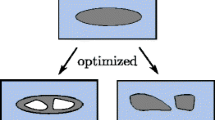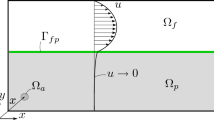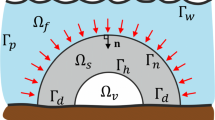Abstract
This study focuses on finding the optimal layout of fluidic devices subjected to incompressible flow at low Reynolds numbers. The proposed approach uses a levelset method to describe the fluid-solid interface geometry. The flow field is modeled by the incompressible Navier–Stokes equations and discretized by the extended finite element method (XFEM). The no-slip condition along the fluid-solid interface is enforced via a stabilized Lagrange multiplier method. Unlike the commonly used porosity approach, the XFEM approach does not rely on a material interpolation scheme, which allows for more flexibility in formulating the design problems. Further, it mitigates shortcomings of the porosity approach, including spurious pressure diffusion through solid material, strong dependency of the accuracy of the boundary enforcement with respect to the model parameters which may affect the optimization results, and poor boundary resolution. Numerical studies verify that the proposed method is able to recover optimization results obtained with the porosity approach. Further, it is demonstrated that the XFEM approach yields physical results for problems that cannot be solved with the porosity approach.
















Similar content being viewed by others
References
Allaire G, Jouve F, Toader A-M (2004) Structural optimization using sensitivity analysis and a level-set method. J Comput Phys 194(1):363–393
Angot P, Bruneau C-H, Fabrie P (1999) A penalization method to take into account obstacles in viscous flows. Numer Math 81:497–520
Belytschko T, Black T (1999) Elastic crack growth in finite elements with minimal remeshing. Int J Numer Methods Eng 45:601–620
Bendsøe MP, Sigmund O (2003) Topology optimization: theory, methods and applications. Springer
Borrvall T, Petersson J (2003) Topology optimization of fluids in Stokes flow. Int J Numer Methods Fluids 41(1):77–107
Brinkman HC (1947) A calculation of the viscous force exerted by a flowing fluid on a dense swarm of particles. Appl Sci Res Sect A 1:27
Burger M, Hackl B, Ring W (2004) Incorporating topological derivatives into level set methods. J Comput Phys 194(1):344–362
Challis V, Guest JK (2009) Level set topology optimization of fluids in Stokes flow. Int J Numer Methods Eng 79(10):1284–1308
Chessa J, Belytschko T (2003) An extended finite element method for two-phase fluids. J Appl Mech 70(1):10–17
Cunha AL (2004) A fully Eulerian method for shape optimization with application to Navier–Stokes flows. PhD thesis, Carnegie Mellon University, Pittsburgh PA, USA
Daoud F, Firl M, Bletzinger K-U (2005) Filter techniques in shape optimization with CAD-free parametrization. In: 6th World congresses of structural and multidisciplinary optimization. Rio de Janeiro, Brazil
Daux C, Moës N, Dolbow J, Sukumar N, Belytschko T (2000) Arbitrary branched and intersecting cracks with the extended finite element method. Int J Numer Methods Eng 48(12):1741–1760
Deng Y, Liu Z, Zhang P, Liu Y, Wu Y (2011) Topology optimization of unsteady incompressible Navier–Stokes flows. J Comput Phys 230(17):6688–6708
De Ruiter MJ, van Keulen F (2004) Topology optimization using a topology description function. Struct Multidisc Optim 26(6):406–416
De Ruiter MJ (2005) Topology optimization using a topology description function approach. PhD thesis, Technical University Delft
Duan X, Ma Y, Zhang R (2008a) Optimal shape control of fluid flow using variational level set method. Phys Lett A 372(9):1374—1379
Duan XB, Ma YC, Zhang R (2008b) Shape-topology optimization of stokes flow via variational level set method. Appl Math Comput 202(1):200–209
Duan XB, Ma YC, Zhang R (2008c) Shape-topology optimization for Navier–Stokes problem using variational level set method. J Comput Appl Math 222(2):487–499
Evgrafov A, Gregersen MM, Sørensen MP (2011) Finite volumes discretization of topology optimization problems. In: USNCCM—11. Minneapolis and St. Paul, Minnesota, Accessed 25–28 July 2011
Gerstenberger A, Wall WA (2008) Enhancement of fixed-grid methods towards complex fluid-structure interaction applications. Int J Numer Methods Fluids 57(9):1227–1248
Gerstenberger A, Wall WA (2010) An embedded Dirichlet formulation for 3D continua. Int J Numer Methods Eng 82(5):537–563
Guest JK, Prévost JH (2006) Topology optimization of creeping fluid flows using a Darcy–Stokes finite element. Int J Numer Methods Engineering 66:461–484
Khadra K, Angot P, Parneix S, Caltagirone JP (2000) Fictitious domain approach for numerical modelling of Navier–Stokes equations. Int J Numer Methods Fluids 34(8):651–684
Kreissl S, Pingen G, Maute K (2009) An explicit level-set approach for generalized shape optimization of fluids with the lattice Boltzmann method. Int J Numer Methods Fluids. doi:10.1002/fld.2193
Kreissl S, Pingen G, Evgrafov A, Maute K (2010) Topology optimization of flexible micro-fluidic devices. Struct Multidisc Optim 42:495–516
Kreissl S, Pingen G, Maute K (2011) Topology optimization for unsteady flow. Int J Numer Methods Eng 87(13):1229–1253
Kuhn HW, Tucker AW (1951) Nonlinear programming. In: Proceedings of the 2nd Berkeley symposium on mathematical statistics and probability, 1950. University of California Press, Berkeley and Los Angeles, pp 481–492
Maute K, Kreissl S, Makhija D, Yang R (2011) Topology optimization of heat conduction in nano-composites. In: Proceedings of the 9th World congress on structural and multidisciplinary optimization. Shizuoka, Japan, 13–17 June 2011
Moës N, Dolbow J, Belytschko T (1999) A finite element method for crack growth without remeshing. Int J Numer Methods Eng 46:131–150
Mohammadi B, Pironneau O (2008) Theory and practice of optimal shape design. Eur J Comput Mech 17(1–2):13–30
Olesen LH, Okkels F, Bruus B (2006) A high-level programming-language implementation of topology optimization applied to steady-state Navier–Stokes flow. Int J Numer Methods Eng 65:975–1001
Osher S, Sethian JA (1988) Fronts propagating with curvature dependent speed: algorithms based on Hamilton–Jacobi formulations. J Comput Phys 79:12–49
Othmer C (2008) A continuous adjoint formulation for the computation of topological and surface sensitivities of ducted flows. Int J Numer Methods Fluids 58(8):861–877
Pingen G, Evgrafov A, Maute K (2007a) Topology optimization of flow domains using the lattice Boltzmann method. Struct Multidisc Optim 36(6):507–524
Pingen G, Waidmann M, Evgrafov A, Maute K (2007b) Application of a parametric level-set approach to topology optimization fluid with the Navier–Stokes and lattice Boltzmann equations. In: WCSMO07. Seoul, Korea, ISSMO, 21–25 May 2007
Pingen G, Waidmann M, Evgrafov A, Maute K (2009) A parametric level-set approach for topology optimization of flow domains. Struct Multidisc Optim 41(1):117–131
Rozvany GIN, Zhou M (1991) Applications of the COC method in layout optimization. In: Eschenauer HA, Mattheck C, Olhoff N (eds) Proc. conference on engineering optimization on design processes. Berlin, Heidelberg, New York, pp 59–70
Sauerland H, Fries T-P (2011) The extended finite element method for two-phase and free-surface flows: a systematic study. J Comput Phys 230(9):3369–3390
Sigmund O, Petersson J (1998) Numerical instabilities in topology optimization: a survey on procedures dealing with checkerboards, mesh-dependencies and local minima. Struct Multidisc Optim 16(1):168–75
Sukumar N, Moës N, Moran B, Belytschko T (2000) Extended finite element method for three-dimensional crack modelling. Int J Numer Methods Eng 48(11):1549–1570
Svanberg K (1995) A globally convergent version of MMA without linesearch. In: Proceedings of the 1st World congress of structural and multidisciplinary optimization. Goslar, Germany, pp 9–16, 28 May–2 June 1995
Tezduyar TE, Mittal S, Ray SE, Shih R (1992) Incompressible flow computations with stabilized bilinear and linear equal-order-interpolation velocity-pressure elements. Comput Methods Appl Mech Eng 95:221–242
Van Miegroet L, Duysinx P (2007) Stress concentration minimization of 2D filets using X-FEM and level set description. Struct Multidisc Optim 33(4–5):425–438
Wang MY, Wang X (2004) PDE-driven level sets, shape sensitivity and curvature flow for structural topology optimization. Comput Model Eng Sci 6(4):373–395
Wang SY, Wang MY (2006) A moving superimposed finite element method for structural topology optimization. Int J Numer Methods Eng 65(11):1892–1922
Wei P, Wang M, Xing, X (2010) A study on X-FEM in continuum structural optimization using a level set model. Comput Aided Des 42(8):708–719. Application-driven Shape Development
Yoon GH (2009) Topology optimization for stationary fluid-structure interaction problems using a new monolithic formulation. In: 8th World congress on structural and multidisciplinary optimization
Zhou S, Li Q (2008) A variational level set method for the topology optimization of steady-state Navier–Stokes flow. J Comput Phys 227(24):10,178–10,195
Acknowledgments
The authors acknowledge the support of the National Science Foundation under grants DMI-0729529 and EFRI-1038305. The opinions and conclusions presented in this paper are those of the authors and do not necessarily reflect the views of the sponsoring organization.
Author information
Authors and Affiliations
Corresponding author
Rights and permissions
About this article
Cite this article
Kreissl, S., Maute, K. Levelset based fluid topology optimization using the extended finite element method. Struct Multidisc Optim 46, 311–326 (2012). https://doi.org/10.1007/s00158-012-0782-8
Received:
Revised:
Accepted:
Published:
Issue Date:
DOI: https://doi.org/10.1007/s00158-012-0782-8




